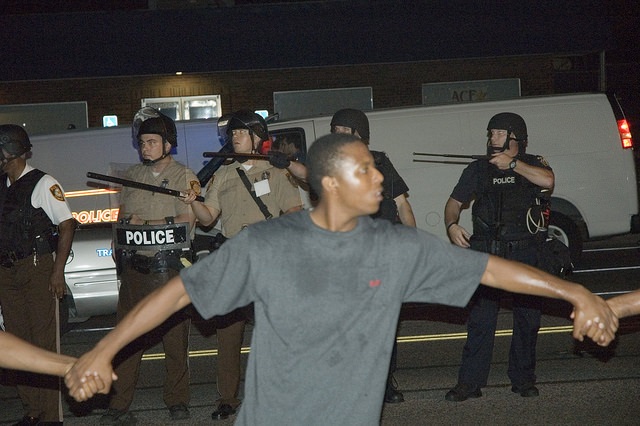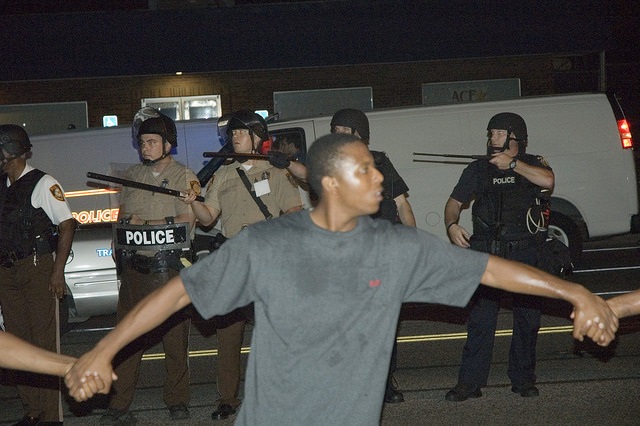
 peoplesworld / Flickr)” width=”640″ height=”426″ />Protest in Ferguson, Missouri for Michael Brown. (Photo: peoplesworld / Flickr)
peoplesworld / Flickr)” width=”640″ height=”426″ />Protest in Ferguson, Missouri for Michael Brown. (Photo: peoplesworld / Flickr)
On a crisp, Fall evening in 1992, while I was a freshman at a SUNY (State University of New York) school, the campus erupted after a white, male student assaulted a black, female student. Being an associate of the African American Student Union Body Association (AASUBA) at the time, I attended an emergency meeting that was called in order to discuss the incident and consider potential responses. The meeting ensued, but there was little discussion. Instead, the room was a hotbed of rage. As one of only two white students among over fifty members and associates, some of the fury was directed at me, literally. I understood why; because I felt the rage myself.
As an 18-year-old overflowing with testosterone-ridden angst, I wanted to find the perpetrator and exact justice on him and anyone who stood by him. I didn’t care to hear an explanation. I had already spent years “undercover in white America,” where I had been privy to the ignorant hatefulness and pervasive racism that filled casual interactions in living rooms and at dinner tables. It was ugly. It was nauseating. I had seen enough in my life – as well as during my few months on campus – to convince me this assault had to be racially motivated. I didn’t need questions asked and answered. Deep down, I already knew. And the fact that this man had targeted a woman only made it that more infuriating.
Had an outsider witnessed what took place in that small conference room, as the few suggestions for a calm and calculated response were quickly drowned out by thundering and profanity-laced calls for violence, they would have likely disregarded or minimized it as “senseless” and “visceral” rage. As I stood there, consumed by the moment, feeling the blood boiling in my veins as my entire body was shaking, my own reaction seemed visceral. I could have nearly fooled myself. But I didn’t; and it wasn’t. Rather, it was the consummation of a series of life events that had left bubbles of emotional fury within me, all of which had been waiting to boil over. As I stood there with my fists clenched, memories flooded my brain.
I immediately recalled the time when my best friend and I were randomly targeted and bullied by a pack of strangers as we walked to the store. The pushing and shoving we experienced were bad enough; however, those physical acts were dwarfed by a slew of racial epithets that were thrown at my friend (who happened to be Black), each one making my gut wrench as I observed the callous and almost entertaining nature in which they were delivered as my friend’s eyes swelled with tears. We were 9 years old. The bullies were much older. We were far outnumbered and much too scared to even consider retaliating. Instead, we both cried as the pack walked away in a celebratory zeal. I would come to realize much later on that this interaction probably was not as random as I had once thought.
I recalled the nights I had stayed up late, as an intensely curious 12-year-old, watching a PBS documentary called “Eyes on the Prize.” I remembered the trance I found myself in while watching Martin Luther King, Jr.’s powerful oratories. I recalled the delightful pride that coursed through my body as I watched Malcolm X put television personalities and interviewers in their place. But, mostly, I thought of the rage that consumed me while I watched rabid racists – both civilian and police – abuse, intimidate, and humiliate Black folks. This rage became internalized as I could not help but see the pack of bullies who had confronted me and my friend years earlier.
I recalled an incident that had occurred only a few months prior, as friends and I were pulled over in a parking lot by two police cars that had come to a screeching halt in front of us. As the three officers exited the vehicles nervously with weapons drawn, the five of us in the car simultaneously instructed one another to show our hands in a feverish instinct of self-preservation. We had done nothing wrong, but that didn’t matter. The officers proceeded to order us from the car, inspect the car, and question us. Eventually, we were allowed to leave – with only an explanation that “someone had made a complaint.” Two of the passengers in the car that night were Black. There is no question in my mind that had we all been white, the incident would have never taken place. Had we all been white, those guns would have never left their respective holsters. And had we all been Black, and this had occurred in St. Louis – or any metropolitan area in the U.S. for that matter – one or all of us may have been shot dead that night, with no explanation or recourse to follow.
I recalled stories my mother had just recently shared with me regarding the underlying racism she experienced at her workplace, much of which she suspected was directed at her son (me) and his best friend – the pair that often stopped in to visit her. Racist pictures being pinned up on display in the break room; the whispers of racist jokes being delivered as she walked by; the stares of ridicule and intimidation that she caught from time to time – All products of a reactionary and racist judgment of something as innocent as her son’s friendship with another boy. This was in the late-1980s, not the 1960s.
On that Fall night in 1992, as news of this assault spread through campus, those recollections in me boiled over. I wanted revenge. I wanted revenge on those racist bullies who had joyfully traumatized a pair of 9-year-old boys walking to the store. I wanted revenge on those racist southerners who had brazenly spilled food on the heads of Black students sitting at the Greensboro Woolworth’s lunch counter. I wanted revenge on the Chicago racist who hurled a rock at Dr. King, hitting him on the head. I wanted revenge on Bull Connor and his sadistic police forces that attacked courageous and non-violent protesters with dogs and high-powered water hoses. I wanted revenge on those cops who recklessly pulled their guns on a car full of teenagers that were doing no wrong. I wanted revenge on my mother’s coworkers for subjecting her to their hateful ignorance. This was my chance to exact that revenge, in one fell swoop.
The white man who had chosen to assault a black woman on campus that night was the physical embodiment of this ugly history that filled me with rage. It was not “visceral.” It was not “senseless.” It was long overdue. Yet, it was merely the product of a series of observations and experiences made and lived by a white male growing up in a mostly-white, small town. Over the course of 18 years, these experiences had been few and far between, yet still forged a conscious anger in me. One can easily presume that these experiences which shaped my rage are hardly comparable to those lived by Black Americans on a daily basis, for years at a time, at an intense rate, and of which have a real impact on the course of a life. Despite the rage that fills me, I still have the option to choose to ignore it, or at the very least tuck it aside from time to time. I am allowed the privilege to hide in my white skin, protected from any real consequences. My experiences do not prevent me from getting a job or suitable apartment. They do not attract unfair treatment from police, judges, and juries. They do not restrict opportunities and resources. And they do not draw suspicious stares, the sound of car doors locking as I walk by, or the constant harassment of store employees.
I am still “undercover in White America.” Citizens in Ferguson, Missouri are not. And their rage is not “senseless” or “visceral”; it is the product of a life full of experiences that have tried to beat them down to their knees; that have attempted to “keep them in their place”; that have yearned to make them feel inferior; that have fought to dehumanize them, their families, and their children. Like most Black Americans, their collective rage is conscious, justified, and long overdue.
Our most important fundraising appeal of the year
December is the most critical time of year for Truthout, because our nonprofit news is funded almost entirely by individual donations from readers like you. So before you navigate away, we ask that you take just a second to support Truthout with a tax-deductible donation.
This year is a little different. We are up against a far-reaching, wide-scale attack on press freedom coming from the Trump administration. 2025 was a year of frightening censorship, news industry corporate consolidation, and worsening financial conditions for progressive nonprofits across the board.
We can only resist Trump’s agenda by cultivating a strong base of support. The right-wing mediasphere is funded comfortably by billionaire owners and venture capitalist philanthropists. At Truthout, we have you.
We’ve set an ambitious target for our year-end campaign — a goal of $119,000 to keep up our fight against authoritarianism in 2026. Please take a meaningful action in this fight: make a one-time or monthly donation to Truthout before December 31. If you have the means, please dig deep.